Can You Put An Enamel Dutch Oven In The Dishwasher?
Enameled Dutch ovens have become a staple in many kitchens, cherished for their versatility and ability to cook a wide range of dishes. However, when it comes to cleaning these prized cookware items, questions often arise about whether it’s safe to put an enameled Dutch oven in the dishwasher.
Putting an enameled Dutch oven in the dishwasher is not recommended. The dishwasher’s abrasive detergents and mechanical actions can damage the delicate enamel coating, leading to chipping and potential rust on the cast iron beneath. Hand washing is the preferred method to maintain its integrity.
The delicate enamel surface can be affected by the dishwasher’s harsh detergents, abrasive cleaning actions, and high-pressure water jets.
Also, the mechanical movements in the dishwasher can lead to the Dutch oven clanking against other items, increasing the likelihood of chipping the enamel.
To maintain the Dutch oven’s integrity, it’s best to opt for gentle hand washing using mild soap and avoid abrasive scouring pads or steel wool.
4 Aspects of Put An Enamel Dutch Oven In The Dishwasher
| Aspect | Description |
|---|---|
| Suitability for Dishwasher | It’s generally not recommended to put an enameled Dutch oven in the dishwasher due to the risk of damage to the enamel coating. |
| Enamel Sensitivity | The delicate enamel surface can be adversely affected by the harsh detergents, abrasive cleaning actions, and high-pressure water jets commonly found in dishwashers. |
| Chipping Hazard | Mechanical movements in the dishwasher can cause the Dutch oven to bump against other items, increasing the likelihood of chipping the enamel, which can expose the cast iron beneath. |
| Preservation of Integrity | To preserve the Dutch oven’s integrity, it’s advisable to choose gentle hand washing using mild soap and soft-bristle scrub brushes, avoiding abrasive scouring pads or steel wool. |

Understanding Enameled Dutch Ovens
Before we tackle the dishwasher question, let’s take a moment to understand what enameled Dutch ovens are and why they are highly regarded in the world of cooking.
Enameled Dutch ovens are made from cast iron and coated with a layer of enamel, typically on both the interior and exterior surfaces. This enamel coating provides several benefits:
- Non-Reactive Surface: The enamel prevents the interaction between acidic foods and the cast iron, making it suitable for a wide range of recipes.
- Easy to Clean: The smooth enamel surface is relatively easy to clean, especially when compared to traditional cast iron cookware.
- Versatile Cooking: Enameled Dutch ovens can be used for braising, stewing, baking, frying, and more. They are known for their ability to distribute heat evenly, making them a go-to choice for slow cooking.
The Dishwasher Dilemma
Now, let’s address the burning question: Can you put an enameled Dutch oven in the dishwasher?
While the convenience of a dishwasher is undeniable, it’s generally not advisable to use it for cleaning enameled Dutch ovens. Here’s why:
Risk of Enamel Damage
Enameled Dutch ovens are designed to be hand-washed. The high-pressure water jets and harsh detergents used in dishwashers can be too abrasive for the enamel coating.
Over time, this can lead to dullness, discoloration, and even chipping of the enamel, compromising the aesthetics and functionality of your Dutch oven.
Increased Likelihood of Chipping
The enamel coating on a Dutch oven is delicate, and the impact of clanking against other dishes in the dishwasher can result in chipping.
Once the enamel is chipped, it can expose the underlying cast iron to moisture, leading to rust and further damage.
Potential Scratching of the Enameled Surface
The dishwasher’s mechanical movements, including spinning racks and the force of water jets, can cause the Dutch oven to shift or bump against other items in the dishwasher.
This movement can lead to scratches on the enameled surface, detracting from its smooth texture.
How to Properly Clean Enameled Dutch Ovens?
Now that we’ve established that the dishwasher isn’t the best choice for cleaning your enameled Dutch oven, let’s explore the recommended methods for maintaining and cleaning this valuable piece of cookware.
Hand Washing
Hand washing your enameled Dutch oven is the safest and most effective way to clean it while preserving its integrity. Here’s a step-by-step guide:
- Cool Down: Allow the Dutch oven to cool to a safe temperature before cleaning.
- Rinse: Rinse the interior with warm water to remove any loose food particles.
- Soap and Scrub Brush: Add a small amount of mild dish soap to warm water. Use a soft-bristle scrub brush or sponge to gently scrub the interior and exterior surfaces. Avoid abrasive scouring pads or steel wool, as they can scratch the enamel.
- Soak: For stubborn stains or burnt-on food, you can fill the Dutch oven with soapy water and let it soak for a few hours or overnight.
- Rinse Thoroughly: Rinse the Dutch oven thoroughly with warm water to remove all soap residue.
- Dry Completely: After rinsing, dry the Dutch oven completely with a towel or by placing it back on the stove over low heat for a few minutes to evaporate any remaining moisture.
Stubborn Stains and Residue Removal
For crusty or stubborn stains, you can use a baking soda paste:
- Make a Paste: Mix baking soda with a small amount of water to create a paste.
- Apply and Wait: Apply the baking soda paste to the affected areas and let it sit for a while until it hardens.
- Boiling Water: Carefully pour boiling water over the baking soda paste to help remove the residue. Use a scrub brush to gently work on the stubborn spots.
- Rinse and Dry: Rinse the Dutch oven thoroughly and ensure it’s completely dry before storing it.
FAQs
Can I Use a Metal Utensil in My Enameled Dutch Oven?
It’s best to avoid using metal utensils, as they can potentially scratch the enamel. Opt for wooden, silicone, or nylon utensils instead.
What Should I Do If My Enameled Dutch Oven Becomes Discolored?
Discoloration can occur over time due to high heat or certain foods. To address this, create a paste using equal parts baking soda and water. Apply it to the discolored areas, let it sit for a while, then scrub and rinse.
Are There Any Specific Cleaning Products I Should Avoid?
Avoid using abrasive cleaners, harsh chemicals, or bleach, as they can damage the enamel. Stick to mild dish soap and gentle cleaning tools.
Conclusion
In conclusion, while the dishwasher is a convenient appliance for cleaning many kitchen items, it’s not the right choice for enameled Dutch ovens.
The risk of enamel damage, chipping, and scratching makes hand washing the preferred method for cleaning and maintaining these versatile cookware pieces.
By following the proper cleaning techniques outlined in this article, you can ensure that your enameled Dutch oven remains in excellent condition and continues to serve you well in the kitchen.





